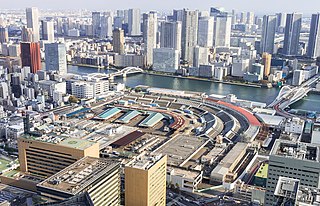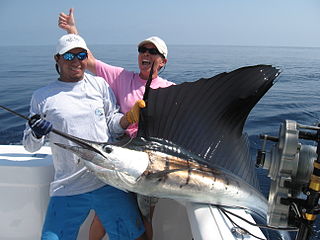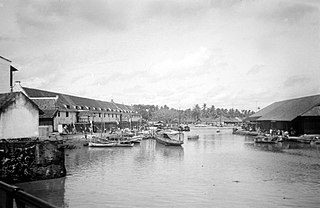
A tuna is a saltwater fish that belongs to the tribe Thunnini, a subgrouping of the Scombridae (mackerel) family. The Thunnini comprise 15 species across five genera, the sizes of which vary greatly, ranging from the bullet tuna up to the Atlantic bluefin tuna, which averages 2 m (6.6 ft) and is believed to live up to 50 years.

The mahi-mahi or common dolphinfish is a surface-dwelling ray-finned fish found in off-shore temperate, tropical, and subtropical waters worldwide. It is also widely called dorado and dolphin. It is one of two members of the family Coryphaenidae, the other being the pompano dolphinfish. These fish are most commonly found in the waters around the Gulf of Mexico, Costa Rica, Hawaii and the Indian Ocean.

Tsukiji Market is a major tourist attraction for both domestic and overseas visitors in Tokyo. Located in Tsukiji in central Tokyo between the Sumida River and the upmarket Ginza shopping district, the area contains retail markets, restaurants, and associated restaurant supply stores. Before 2018, it was the largest wholesale fish and seafood market in the world. The market opened on 11 February 1935 as a replacement for an older market that was destroyed in the 1923 Great Kantō earthquake. It was closed on 6 October 2018, with wholesale operations moving to the new Toyosu Market. The area where the old market was located was demolished and will be rebuilt into a new economic complex featuring a brand new stadium for the Yomiuri Giants of the Nippon Professional Baseball.

The yellowfin tuna, also known as the Albacore tuna, is a species of tuna found in pelagic waters of tropical and subtropical oceans worldwide.

Wahoo is a scombrid fish found worldwide in tropical and subtropical seas. It is best known to sports fishermen, as its speed and high-quality flesh makes it a prized and valued game fish.

Daigo Fukuryū Maru was a Japanese tuna fishing boat with a crew of 23 men which was contaminated by nuclear fallout from the United States Castle Bravo thermonuclear weapon test at Bikini Atoll on March 1, 1954.

A fish aggregatingdevice (FAD) is a man-made object used to attract pelagic fish such as marlin, tuna and mahi-mahi. They usually consist of buoys or floats tethered to the ocean floor. Various types of FADs have been employed in the traditional fishing cultures of Island Southeast Asia, Japan, and Malta for centuries. Modern FADs are increasingly being used in modern commercial and sport fishing.

Poke is a dish of diced raw fish tossed in sauce and served either as an appetizer or a main course.

Salt Water Sportsman is a monthly magazine about recreational marine fishing in the United States and throughout the world. Originally published in Boston, Massachusetts in 1939, Salt Water Sportsman expanded from its roots covering New England waters to address saltwater fishing issues throughout the world. The magazine is based in Winter Park, Florida.

A fish market is a marketplace for selling fish and fish products. It can be dedicated to wholesale trade between fishermen and fish merchants, or to the sale of seafood to individual consumers, or to both. Retail fish markets, a type of wet market, often sell street food as well.

The Pacific bluefin tuna is a predatory species of tuna found widely in the northern Pacific Ocean, but it is migratory and also recorded as a visitor to the south Pacific.

A fish fillet, from the French word filet meaning a thread or strip, is the flesh of a fish which has been cut or sliced away from the bone by cutting lengthwise along one side of the fish parallel to the backbone. In preparation for filleting, any scales on the fish should be removed. The contents of the stomach also need careful detaching from the fillet. Because fish fillets do not contain the larger bones running along the vertebrae, they are often said to be "boneless". However, some species, such as the common carp, have smaller intramuscular bones called pins within the fillet. The skin present on one side may or may not be stripped from the fillet. Butterfly fillets can be produced by cutting the fillets on each side in such a way that they are held together by the flesh and skin of the belly.

Mahi-mahi are swift and acrobatic game fish with striking colours. These colours darken when the fish dies The current IGFA all tackle record is 39.91 kilograms (88lb), caught in 1998 in Exuma, Bahamas by Chris Johnson of Lake Mary, Florida. Catches average 7 to 13 kilograms, and any mahi-mahi over 18 kilograms (40 lb) is exceptional. Males are often larger than females.
Seafood species can be mislabelled in misleading ways. This article examines the history and types of mislabelling, and looks at the current state of the law in different locations.

The Toyosu Market is a wholesale market in Tokyo, located in the Toyosu area of the Kōtō ward. There are two markets for seafood, one for general wholesale and one for bidding, and one market for fruits and vegetables, with each in its own building. Tourists can observe the auction market on a second floor viewing deck. There are restaurants with fresh seafood and produce from the market and shops. The market is built on reclaimed land in Tokyo Bay, and replaces the historic Tsukiji fish market, which now is a major tourist attraction. Auction tours, events, merchandise sales and restaurants can be used by general consumers and tourists. When it opened on 11 October 2018, it became the largest wholesale fish market in the world.

Muara Angke is a fishing port located at Kapuk Muara, Penjaringan, along the north coast of Jakarta, Indonesia. The port is integrated with fishermen's housing and a fishing port management office owned by the Jakarta government. It has a modern fish market with supporting facilities for landing and auction of fish. The port is located at the mouth of the Angke River, where it meets the Java Sea. Muara Angke Wildlife Reserve is also located in this area, adjacent to Muara Karang.

US FWS Hugh M. Smith was an American fisheries science research vessel in commission from 1949 to 1959 in the fleet of the United States Department of the Interior's Fish and Wildlife Service. She was among the first U.S. fisheries science vessels to explore the central Pacific Ocean in search of commercially valuable populations of fish.

US FWS Charles H. Gilbert was an American fisheries science research vessel in commission from 1952 to 1970 in the fleet of the United States Department of the Interior's Fish and Wildlife Service and from 1970 to 1973 in the fleet of the National Oceanic Atmospheric Administration as NOAAS Charles H. Gilbert. She was among the first U.S. fisheries science vessels to explore the central Pacific Ocean in search of commercially valuable populations of fish.

Tamashiro Market is a family-run seafood market located in Downtown Honolulu on North King Street for over 60 years. It was founded by Walter Tamashiro after a tsumani hit Hilo in 1946, where the Tamashiro family previously lived. Fresh fish sales are 75 percent of the market's business. The market also sells prepared poké, fish jerky, various sea vegetables and edible seaweeds, and a range of tropical fruits.




















